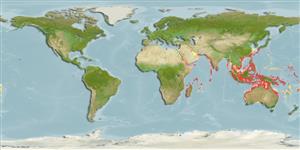Environment: milieu / climate zone / depth range / distribution range
Écologie
marin; saumâtre récifal; profondeur 0 - 20 m (Ref. 127989). Subtropical; 32°N - 33°S, 28°E - 178°W
Indo-West Pacific: Red Sea and East Africa to southern Japan, New Guinea and Arafura Sea (Ref. 9819). Reported from Vanuatu (Ref. 13300). Migrated to the Mediterranean from the Red Sea via the Suez Canal (Ref. 5385).
Taille / Poids / Âge
Maturity: Lm ? range ? - ? cm
Max length : 30.0 cm TL mâle / non sexé; (Ref. 30573)
Épines dorsales (Total) : 12 - 13; Rayons mous dorsaux (Total) : 8 - 11; Épines anales: 3; Rayons mous anaux: 9 - 11. Generally silver in color, with 4-6 dark horizontal lines; a black blotch behind head and below dorsal origin and another in front of dorsal fin may be present; caudal fin pale or slightly dusky (Ref. 4327).
Are coastal species often found in brackish waters; common in estuaries. They croak when taken from the water. Usually forming schools. Juveniles in seagrass beds and in mangrove bays (Ref. 48635). Feed on small fishes and invertebrates. Eggs are guarded and fanned by the male parent (Ref. 205). Maximum depth reported taken from Ref. 127989.
Life cycle and mating behavior
Maturities | Reproduction | Spawnings | Egg(s) | Fecundities | Larves
Eggs are guarded and fanned by the male parent (Ref. 205).
Paxton, J.R., D.F. Hoese, G.R. Allen and J.E. Hanley, 1989. Pisces. Petromyzontidae to Carangidae. Zoological Catalogue of Australia, Vol. 7. Australian Government Publishing Service, Canberra, 665 p. (Ref. 7300)
Statut dans la liste rouge de l'IUCN (Ref. 130435)
Menace pour l'homme
Harmless
Utilisations par l'homme
Pêcheries: intérêt commercial mineur
Outils
Articles particuliers
Télécharger en XML
Sources Internet
Estimates based on models
Preferred temperature (Ref.
123201): 24.4 - 29, mean 28 °C (based on 1262 cells).
Phylogenetic diversity index (Ref.
82804): PD
50 = 0.6250 [Uniqueness, from 0.5 = low to 2.0 = high].
Bayesian length-weight: a=0.01047 (0.00667 - 0.01644), b=3.01 (2.88 - 3.14), in cm total length, based on LWR estimates for this species & (Sub)family-body (Ref.
93245).
Niveau trophique (Ref.
69278): 3.6 ±0.4 se; based on diet studies.
Résilience (Ref.
120179): Milieu, temps minimum de doublement de population : 1,4 à 4,4 années (Preliminary K or Fecundity.).
Fishing Vulnerability (Ref.
59153): Low vulnerability (20 of 100).
Climate Vulnerability (Ref.
125649): Moderate to high vulnerability (50 of 100).
Nutrients (Ref.
124155): Calcium = 34.7 [16.7, 81.9] mg/100g; Iron = 0.604 [0.350, 0.984] mg/100g; Protein = 20.1 [19.1, 21.1] %; Omega3 = 0.256 [0.154, 0.426] g/100g; Selenium = 14.2 [6.9, 26.8] μg/100g; VitaminA = 50.8 [15.9, 162.8] μg/100g; Zinc = 0.954 [0.631, 1.405] mg/100g (wet weight);
